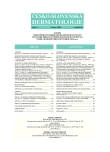The Significance of Sentinel Node Examination in Melanoma. Part II: Results of Sentinel Node Examination in a group of 177 patients of The Department of Dermatology of General Teaching Hospital
Authors:
I. Krajsová 1; I. Vítková 3; J. Šuk 2; I. Procházková 1; T. Šuková 1; A. Vokáčová 4
Authors‘ workplace:
Dermatovenerologická klinika VFN a 1. LF UK
přednosta prof. MUDr. J. Štork, CSc.
1; Chirurgická klinika VFN a 1. LF UK
přednosta doc. MUDr. J. Šváb, CSc.
2; Patologicko-anatomický ústav VFN a 1. LF UK
přednosta prof. MUDr. C. Povýšil, DrSc.
3; Ústav nukleární medicíny VFN a 1. LF UK
přednosta prof. MUDr. M. Šámal, DrSc.
4
Published in:
Čes-slov Derm, 80, 2005, No. 3, p. 147-155
Category:
Clinical and laboratory Research
Overview
Since the year 2001 the sentinel lymph node (SLN) biopsy is the part of a standard care of patients with melanoma examined at melanoma clinic of The Department of Dermatology of General Teaching Hospital. Preoperative lymphoscintigraphy and intra-operative SLN mapping and biopsy had no complications and minimal burden for the patients. In agreement with literature data the positive SLN were found in one third of patients with advanced melanoma, higher Breslow thickness and Clark’s level and more often described ulceration in comparison with those who had no SLN metastases. Despite the short follow-up period from 0,8 to 47,3 months it is, already, possible to observe the differences in SLN positive patients survival what confirms, that micrometastases detection in the sentinel lymph nodes is a significant independent prognostic factor determining the unfavourable disease course in these patients.
Key words:
melanoma – sentinel lymph node – micrometastases – disease prognosis
Labels
Dermatology & STDs Paediatric dermatology & STDsArticle was published in
Czech-Slovak Dermatology

2005 Issue 3
Most read in this issue
- Melanoma of the External Ear
- The Significance of Sentinel Node Examination in Melanoma: Part I. A Review
- The Significance of Sentinel Node Examination in Melanoma. Part II: Results of Sentinel Node Examination in a group of 177 patients of The Department of Dermatology of General Teaching Hospital
- Use of Dermatoscopy in the Differential Diagnosis of Non-Melanocytic Lesions and Malignant melanoma
